Wild birds are defined as any bird other than poultry and caged birds. They are typically the birds that sing outside your window in the spring, tap on tree trunks as you hike wooded trails, and visit your backyard feeders in search of seeds and mealworms. Discover 11 types of wild birds and learn about their habitats, diet, nests, and physical characteristics.
American Goldfinch
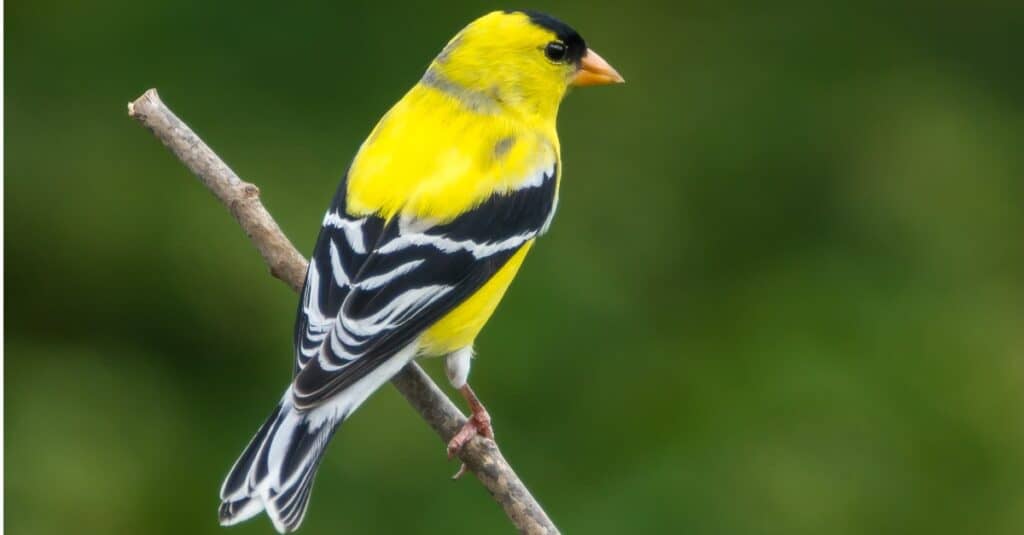
The American goldfinch averages around five inches in length. They are small finches with short bills and notched tails.
©iStock.com/impr2003
Range and Habitat: The American goldfinch is abundant throughout North America, where they breed in Southern Canada and the Northern United States and winter in the South and Mexico. They live in weeds and thistles along roadsides, open fields, and wood edges.
Appearance: They are small finches with short bills and notched tails. Breeding males are bright yellow with black caps and black wings with white patches.
Diet: Seeds and insects
Vocalizations: Long series of twitters and warbles
Nests: A compact plant fiber and spider web cup in deciduous trees and shrubs
Varied Thrush
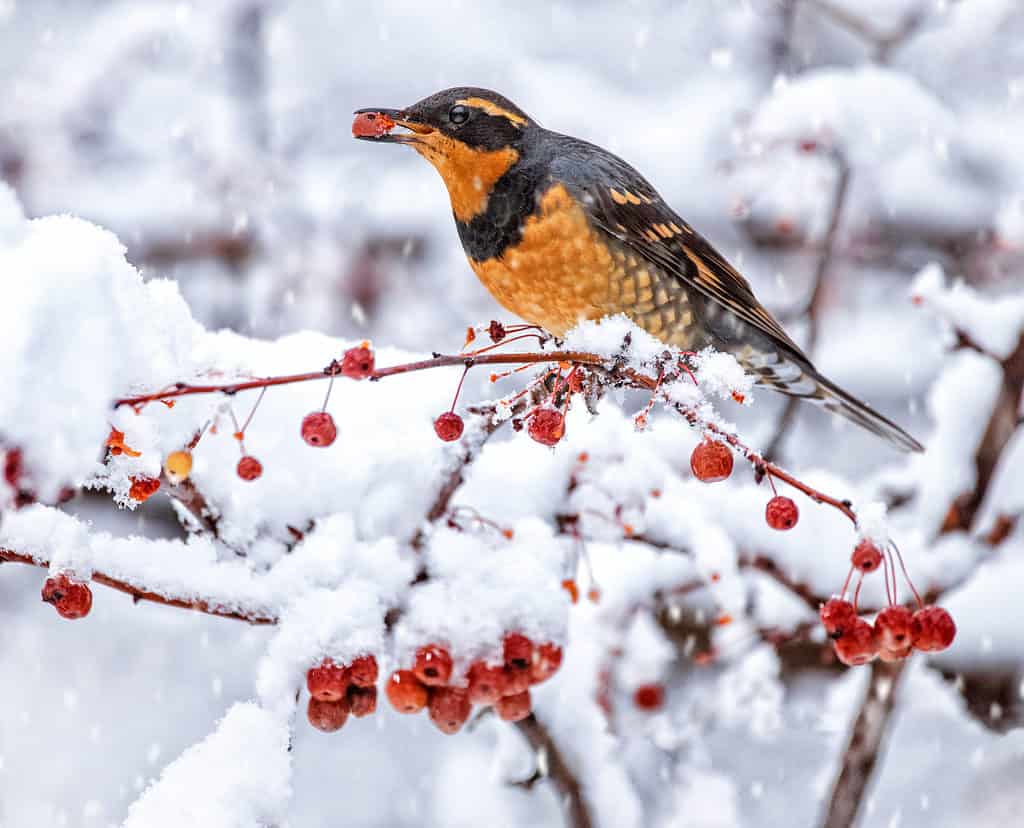
The varied thrush is a large, stocky bird native to the Western United States and Canada. They inhabit dark, moist forests, parks, and gardens.
©Annette Shaff/Shutterstock.com
Range and Habitat: The varied thrush is a familiar sight in the Western United States, Canada, and Alaska. In the Pacific Northwest, they inhabit dark moist forests, breeding in fir, hemlock, and spruce trees with dense understory. Their winter habitats are much more varied, such as parks and gardens.
Appearance: They are large, stocky thrushes with round heads and straight bills. Their plumage is dark gray and burnt orange.
Diet: Insects, berries, and wild fruits
Vocalizations: Buzzy whistles
Nests: A twig and moss cup placed in a conifer near the base
Black-Capped Chickadee

The black-capped chickadee is a tiny, compact bird with a short bills, a short neck, and a large head. They live in forests, open woods, thickets, parks, and groves.
©Rob Palmer Photography/Shutterstock.com
Range and Habitat: Black-capped chickadees live permanently in Canada and the Northern United States. They live in mixed and deciduous forests, open woods, willow thickets, parks, groves, and shade trees.
Appearance: These birds are tiny and compact with short bills, short necks, and large heads. They are streaky gray above and whitish below, with black caps, black bibs, and white cheeks.
Diet: Insects, seeds, and berries
Vocalizations: Buzzy and clear whistles
Nests: Tree cavities lined with moss and animal hair
Tufted Titmouse

The tufted titmouse is a small and plump bird with large eyes and gray plumage. They live permanently in the Eastern United States.
©Rich Waite/Shutterstock.com
Range and Habitat: The tufted titmouse lives year-round in the Eastern United States. They live in deciduous and evergreen woods with dense canopies. You can also find them in groves, orchards, suburbs, and city parks.
Appearance: Small and plump, the tufted titmouse has large eyes and a thick neck. They are gray above and white below, with light peach wash on the sides.
Diet: Insects, seeds, nuts, berries, and fruits
Vocalizations: A series of repeated whistles
Nests: They line a cavity with grass, moss, and other soft material
Brown-Headed Cowbird
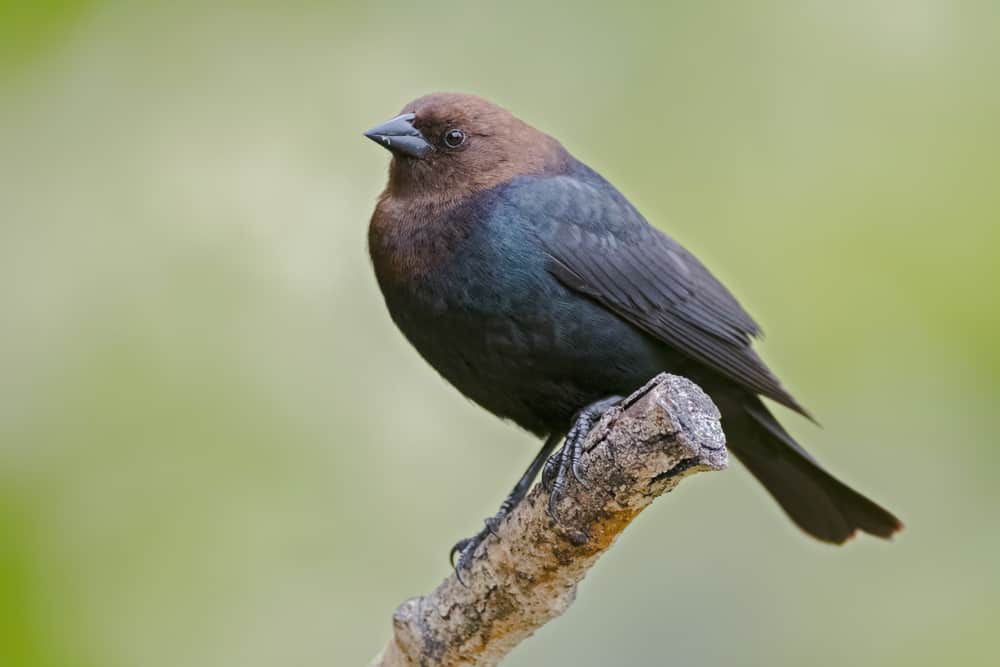
Brown-headed cowbirds breed across Canada and the Western United States before heading to Mexico for the winter.
©punkbirdr/Shutterstock.com
Range and Habitat: Brown-headed cowbirds are abundant in North America, breeding in Canada and the Western United States before heading to Mexico for the winter. However, populations in the Southern and Eastern US live there permanently. You can spot them in farms, fields, prairies, and pastures.
Appearance: They are relatively small and chunky for blackbirds and feature conical bills and short tails. They have glossy black bodies and brown heads.
Diet: Seeds and insects
Vocalizations: Squeaky gurgles
Nests: They don’t make nests. Instead, they lay their eggs in the nests of other birds.
Song Sparrow
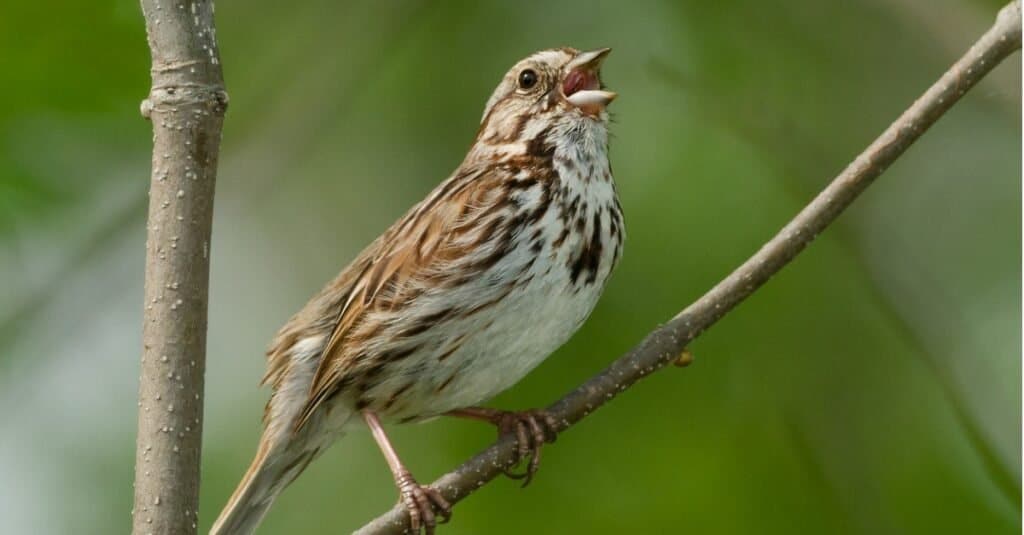
The song sparrow is a medium-sized sparrow, with a round head and a long tail. Their plumage is streaky reddish-brown, gray, and white.
©iStock.com/PaulReevesPhotography
Range and Habitat: Song sparrows spend springs and summers in Canada, live year-round in the Northern United States, and winter in the Southern US. They live in many open habitats, such as arctic grasslands, desert scrub, prairies, and tidal marshes.
Appearance: The sparrows are medium-sized with round heads and long tails. Their plumage is streaky reddish-brown, gray, and white.
Diet: Insects, seeds, and small crustaceans
Vocalizations: Loud, short phrases and trills
Nests: Open cups of grass and weeds on the ground hidden under vegetation.
Dark-Eyed Junco
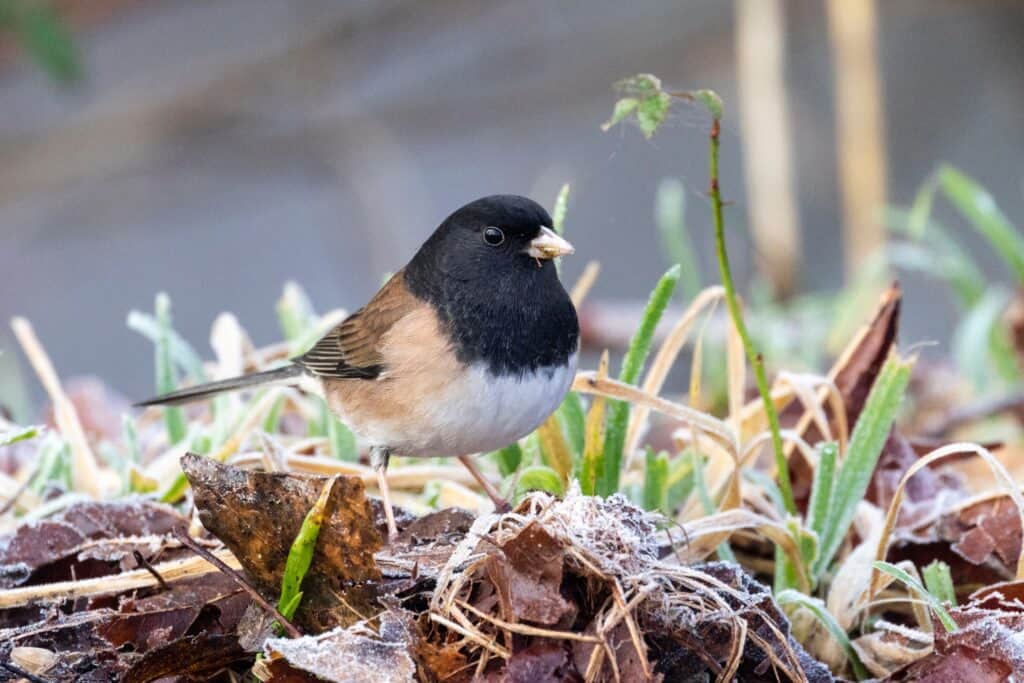
Dark-eyed juncos measure up to 6.3 inches in length and weigh up to 1.1 ounces. They are medium-sized sparrows with round heads and long tails.
©Feng Yu/Shutterstock.com
Range and Habitat: Dark-eye juncos are wintering birds in the United States that head north into Canada during spring. During the breeding season, you can find them in many forest habitats. But their winter grounds are varied and include fields, parks, gardens, and open woodlands.
Appearance: Another medium-sized sparrow with a rounded head, a small bill, and a long tail. They are dark gray with white bellies and pale beaks. They also have white tail feathers.
Diet: Seeds, insects, and berries
Vocalizations: Metallic and buzzy trills
Nests: An open grass cup well hidden on the ground
Red-Breasted Nuthatch
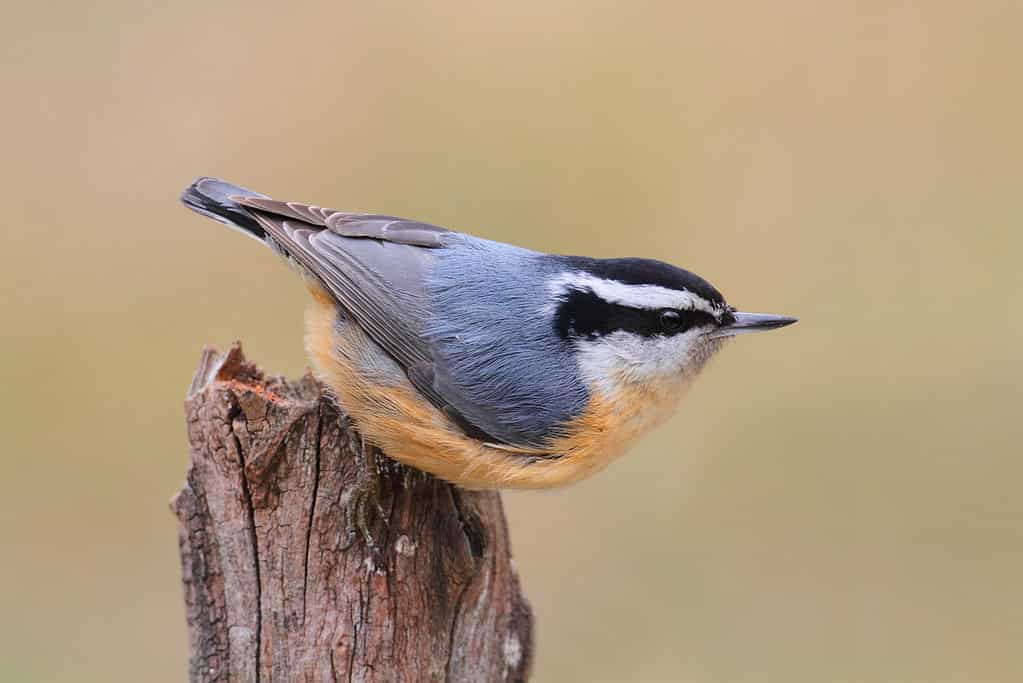
The red-breasted nuthatch lives in coniferous forests and deciduous woods in the United States and Canada.
©iStock.com/SteveByland
Range and Habitat: The red-breasted nuthatch lives year-round in Canada and most of the Western United States, wintering in the east. They live primarily in coniferous forests, except in the Eastern US, where they use deciduous woods. You can also spot them in orchards, parks, and scrubby areas.
Appearance: They are small and compact and feature short tails and long bills. They are bluish-gray with rusty red breasts and black and white heads.
Diet: Insects and seeds
Vocalizations: High-pitched nasal calls
Nests: They line rotten stub cavities with soft grass and moss
Evening Grosbeak
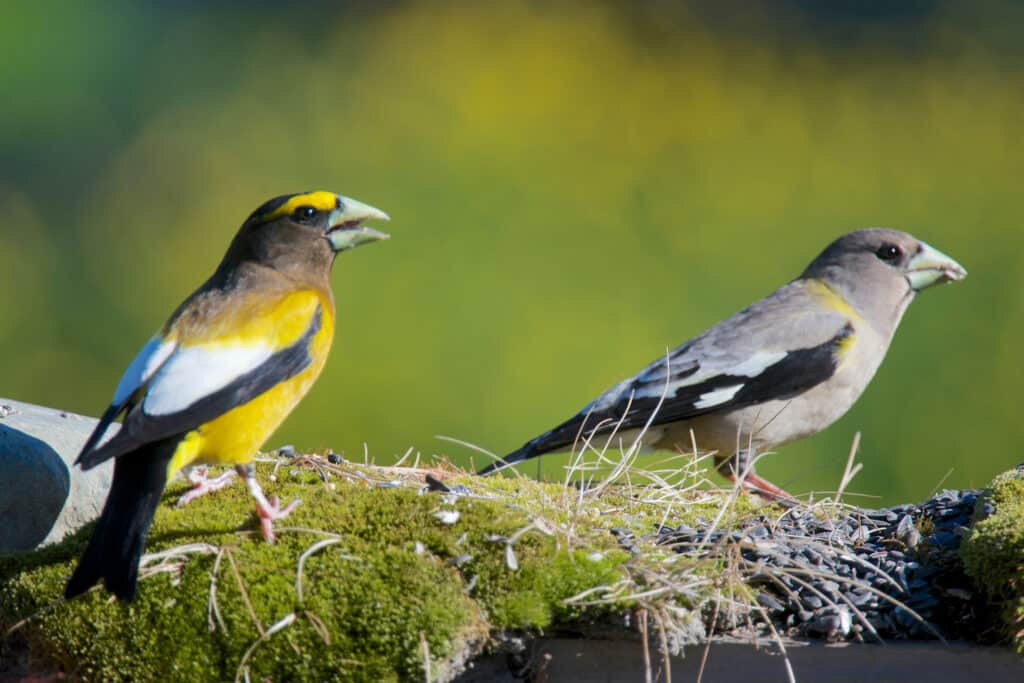
The evening grosbeak lives in the Northern United States, where they inhabit deciduous and coniferous forests. They also live in urban and suburban areas.
©Danita Delimont/Shutterstock.com
Range and Habitat: Evening grosbeaks live in Southern Canada and the very northern regions of the United States. They mainly inhabit deciduous and coniferous forests but can also live in urban and suburban areas.
Appearance: These finches are large and bulky with thick, conical bills and short tails. Adult males are bright yellow, black, and white.
Diet: Seeds, berries, and insects
Vocalizations: Short, musical whistles
Nests: A loose twig cup on a horizontal branch
Hairy Woodpecker
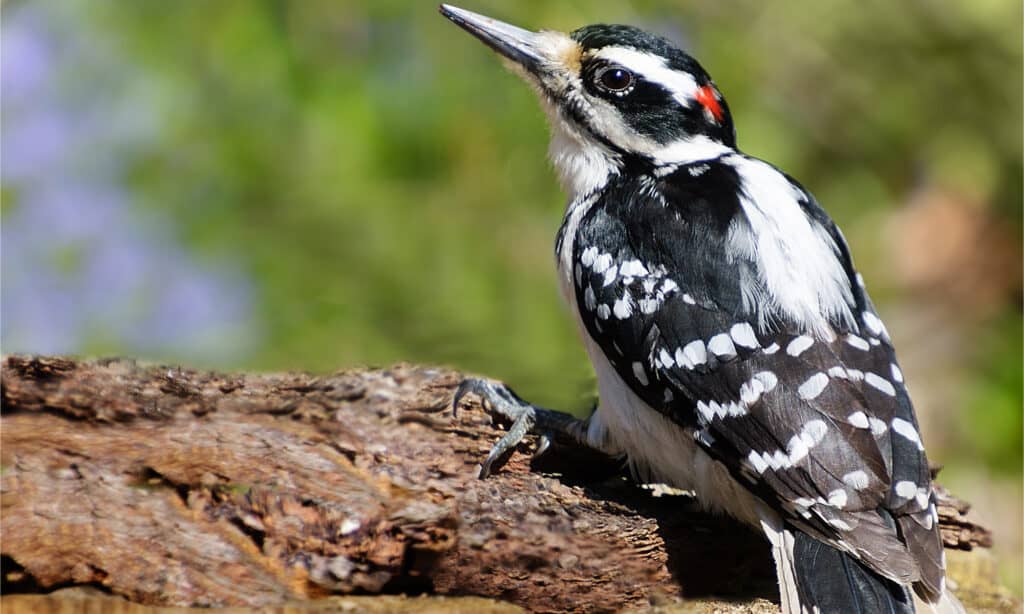
Hairy woodpeckers are endemic to North America, where they live in mature woodlands, forests, parks, and suburban lawns.
©K Quinn Ferris/Shutterstock.com
Range and Habitat: Hairy woodpeckers are permanent residents across most of Canada, the United States, and Mexico. They are abundant in mature woodlands and coniferous and deciduous forests. But they may also stop by parks, woodlots, and suburban lawns.
Appearance: These medium-sized woodpeckers have squared heads and long, straight bills. They have black and white checkered plumage with a flash of red on their crowns.
Diet: Insects, berries, seeds, and nuts
Vocalizations: Loud, sharp notes
Nests: They nest in tree cavities
Purple Finch

The purple finch is a small finch with a conical bill and a short tail. Males have reddish-pink heads and streaky brown backs.
©Fiona M. Donnelly/Shutterstock.com
Range and Habitat: Purple finches breed in Canada and winter in the Eastern US. Although populations in the Northeast and Northwest stay in their environments year-round. Search for them in cool, moist evergreen forests, weedy fields, wooded backyards, and along streams.
Appearance: They are small finches with conical bills and short tails. Males are reddish-pink with streaky brown backs and cloudy white bellies.
Diet: Seeds, buds, berries, and insects
Vocalizations: rich, musical warbles
Nests: A compact twig cup in a tree fork
Thank you for reading! Have some feedback for us? Contact the AZ Animals editorial team.








